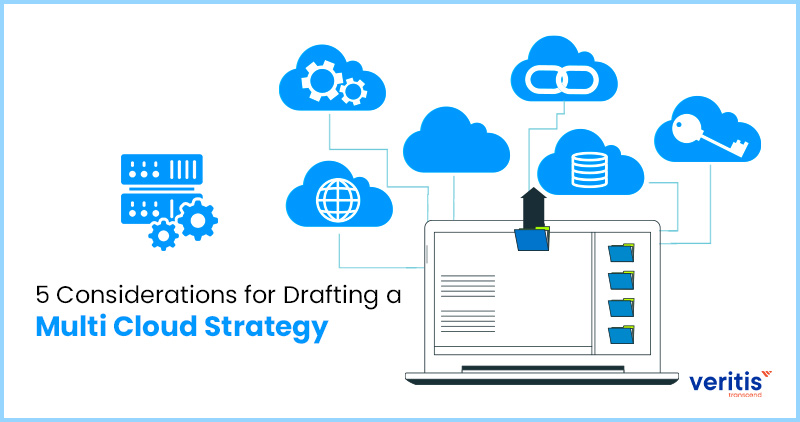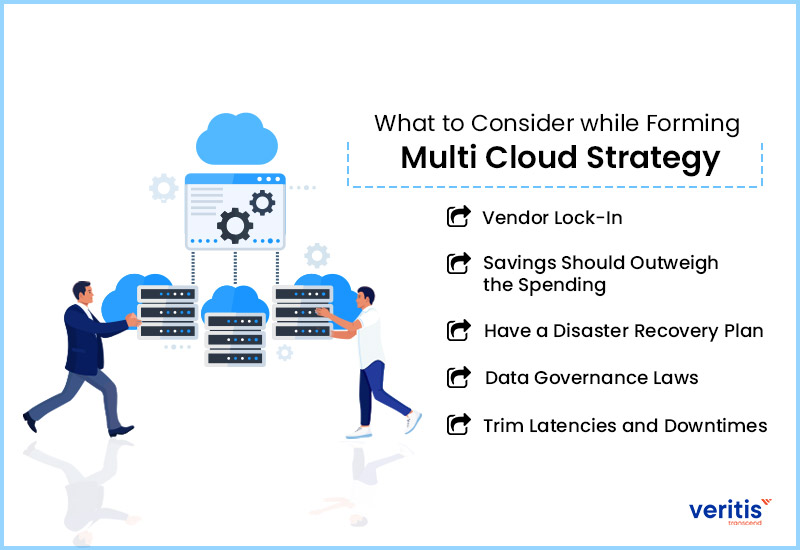
For several years, information technology has advanced quickly, bringing more powerful and flexible cloud computing, richer software, better analytics, mobility, and sensors. If only most vendors of corporate IT were keeping up. The incumbent worldview reflects their education in the previous era of proprietary systems, increased switching costs, and vendor lock-in.
The cloud transformation tendency toward hybrid and multi cloud solution is the best illustration of this. Both times, users may make greater use of already-existing resources and benefit from novel methods of computing, storing, and analysing data thanks to cloud management tools. This is a fact, not a theory. 81% of firms, according to Gartner, collaborate with two or more public cloud providers. Moreover, the multi cloud strategy is gaining traction as companies shall have the option to use various clouds instead of restricting to one.
Single-cloud stacks, however, come at a hefty price. There is increasing complexity and the restriction of proprietary systems where there may be greater power taken from the distinctive capabilities of every cloud. There are segregated data sets where there may be a better understanding. There is concentrated danger in areas where completely different systems may be resilient. There are obstacles in places where there may be more innovation and efficiency. Lack of control, haphazard security, and opaque expenses exist when there may be a single view of assets.
So, without further ado, let’s look at multi cloud strategy and what one must consider while drafting the IT strategy.
Consult our Cloud Consulting Expert
What is Multi Cloud?

Two trends in the world of cloud computing over the past 15 years have contributed to the transition to multi cloud strategy. First, IT departments wishing to migrate to the cloud no longer rely solely on the “Big Three” of AWS, GCP, and Azure. Specialized infrastructure as a service (IaaS) provider has developed to compete with the Big Three since the debut of AWS in 2006, providing businesses with more alternatives for multi cloud deployments.
Second, several businesses invested heavily in cloud migration ten years after AWS’s debut. As a result, today’s start-ups rely on cloud native services, while established businesses are prepared to maximize their cloud deployments.
Employing two or more cloud computing services is known as a multi-cloud approach. Even though a multi cloud deployment can refer to any implementation of multiple software as a service (SaaS) or platform as a service (PaaS) cloud offering, it now most frequently refers to a combination of public infrastructure as a service (IaaS) environment, such as Amazon Web Services and Microsoft Azure.
Many multi cloud deployments nowadays are motivated by vendor lock-in and redundancy concerns, but they are also driven by business and technical objectives. These objectives may involve using more affordable cloud services or utilizing the speed, capacity, or capabilities provided by a particular cloud provider in a specific location.
Additionally, some businesses seek multi cloud architectures because they value their data sovereignty. Enterprise data must physically live in particular locations as required by specific laws, rules, and business policies. Since customers may choose from various IaaS providers’ data center locations or availability zones, multi-cloud computing can assist enterprises in meeting these needs. Organizations may place computing resources as near to end users as feasible to get the best performance and low latency thanks to the flexibility of where cloud data sets. Once the on-premises infrastructure has been moved to the cloud, they can concentrate on designing their cloud environments to take full advantage of multi cloud strategy. Let’s look at the vital aspects that would help you build a sound multi cloud management platform strategy.
Useful link: Multi-cloud, the Future of Enterprise Cloud Computing
What to Consider while Forming Multi Cloud Strategy

It is a given that every company is unique due to its business goals and vision. Due to these factors, a standard policy is non-existential, and this factor, among others, motivates enterprises to seek the services of the Stevie Award winner Veritis. However, there are always vital considerations that one needs to consider for the multi-cloud strategy.
1. Vendor Lock-In
A key strategic driver for adopting a multi cloud strategy is the desire to avoid the dangers of vendor lock-in. Accordingly, workloads may be migrated based on which supplier has the best price structure for the precise resources or possesses the tools necessary to optimize performance. However, most significantly, from a tactical standpoint, it shifts the balance of power from the supplier to you.
If you are an enterprise-level user, you will be better positioned to bargain for a unique pricing structure or other concessions. Additionally, you won’t be at risk of your cloud provider being a single point of failure.
Vendor lock-in, however, is not always the case that should be “should be avoided if feasible” due to several other factors. You may optimize workloads, particularly for a single IaaS platform, and make the maximum use of its native tools and capabilities by building for and executing workloads on that platform. As a result, concerns about vendor lock-in may be overstated, as we’ll discuss in more depth in the section after this.
2. Savings Should Outweigh the Spending
Building cloud-independent apps as part of a multi cloud strategy require a more significant upfront resource commitment. It takes more time and requires professional knowledge and experience. Additionally, it is difficult for workloads and applications to be entirely cloud-agnostic; usually, some customization or tuning is needed.
However, that front-loaded distribution of extra resources has the potential to spare a company from later, far higher costs and hassles. At a certain level of scale, moving workloads to the cloud provider that offers the best price to feature balance for a particular workload at any given moment might result in much more substantial savings than the additional original development cost.
3. Have a Disaster Recovery Plan
One of the main benefits of running a multi cloud solution is establishing redundancy and preparing for disaster recovery. Keeping three copies of their data on two distinct media types, including one off-site, helps IT departments establish a contemporary 3-2-1 backup plan. The evolution of 3-2-1 meant that the other two copies were stored on-site to facilitate quick recoveries.
The requirement for an on-premises backup evolved as cloud services advanced. Today, many businesses no longer use physical infrastructure since data can be restored from the cloud just as rapidly as it can from on-premises equipment. Maintaining data across various public clouds lowers the risk when storing production and backup copies with a single provider for businesses that wish to become or are currently cloud native services. Additionally, the multi cloud solution may recover data from their other, distinct cloud environment, ideally one that provides capabilities in the case of a disaster or ransomware attack.
4. Data Governance Laws
Several nations, including the European Union, have passed laws that control where and how data can be held. Businesses adhering to these data residency regulations might use a multi-cloud strategy to ensure their data complies with legal obligations. They employ several public cloud providers with various geographic reach in places where data storage is necessary.
5. Trim Latencies and Downtimes
A multi cloud architecture eliminates any possibility of severe app outage. Another cloud serves as the failover option, taking over the processing of the service if the primary cloud has trouble processing a particular service, such as an e-commerce transaction. The tasks may be automatically transferred back to the original cloud once it usually operates again.
Additionally, despite the rarity, catastrophic outages do occur. There is always a chance that a significant or minor outage will interfere with the services offered by one provider. Multi cloud deployment is essential if it’s essential that an app has as near to 100% availability as possible at all times.
An insurance policy against DDoS assaults, which can knock down a website or application and keep it down, is a multi-cloud strategy. The rise in brute-force DDoS assaults has been a harmful side effect of expanding cloud installations. However, multi-cloud deployment gives an extra layer of resilience against danger. The load will instantly and smoothly move to another cloud environment, keeping the application up and operating if the leading cloud platform is the target of a DDoS assault.
Useful link: How to Enhance Security in the Multi-Cloud Era
Conclusion
An organization’s DevOps teams and the management overseeing the operation of specific apps frequently prefer a multi-cloud approach over management and C-Suite priorities.
As we’ve seen, both a multi-cloud strategy and one that establishes a stronger bond with (or dependence on) a single public cloud provider have benefits and drawbacks. A multi cloud approach saves costs while enhancing flexibility, performance, and dependability. However, unacceptable conditions might lead to the opposite outcome. To avoid such unwanted outcomes, reach out to Veritis, and we shall customize a solution based on your requirements.
Explore Cloud Services Got Questions? Schedule A Call
More Articles:
- Hybrid Cloud Vs Multi Cloud: What’s the Difference!
- Cloud Migration and IT Infra Support to Multimedia Industry
- Multi-Cloud Environments Alter Firms’ Cloud Strategies
- Cloud: The Technology Reinventing the Global Work Culture
- Cloud Adoption Strategy: Which Approach Would be Most Effective for Your Company?
- What is Cloud Migration? Strategy, Process, and Tools
- Cloud Security Automation: Best Practices, Strategy, and Benefits